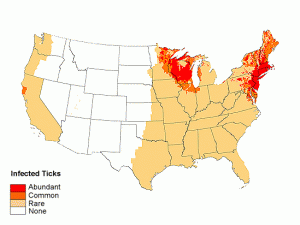The “Other” Vaccines: Lepto and Lyme
Non-core diseases are restricted in their geographic distribution, are often only found seasonally in certain parts of the country, are self-limiting or respond readily to treatment, have low mortality rates, and have vaccines that are very limited in their effectiveness (unlike the vaccines of the core diseases, which are approximately 99% effective). So, what about the “other” dog vaccines for these “non-core” diseases?
Unfortunately, while many dogs will not come into contact with these non-core diseases, they are often vaccinated for them anyway! This blog will discuss Leptospirosis and Lyme disease, while next blog will cover Kennel Cough, the Rattlesnake Vaccine, and Dr. Jean Dodds’ recommendations on non-core dog vaccinations.
Leptospirosis
Leptospirosis, commonly called Lepto, is the “L” in the DHLPP vaccine. Lepto is a bacteria that is carried in the urine of infected animals (typically wildlife, particularly rodents), and that requires warm, wet climates to thrive. It is found most commonly in the southern and southeastern states of the U.S.
Both humans and dogs can be affected by Lepto, which means a person with an infected dog must be very careful in treating and cleaning up after their pet. This bacteria affects the liver and kidneys, and can be potentially fatal if left untreated. Because it is a bacteria, this disease can be readily treated with antibiotics if caught early enough. Many dogs remain asymptomatic despite infection with any of the Leptospira species.
Leptospirosis has over 200 different serovars (types) that are found naturally. Only 4 of these are covered by the Lepto vaccine. There is minimal to no cross-protection between the different strains of Leptospirosis. Thus, even though a dog has been vaccinated for Lepto, he can still contract the disease. If Lepto is suspected, the dog should be treated immediately with antibiotics regardless of vaccination history.
The Leptospirosis vaccine is short-lived, with a wide duration of immunity ranging from 3 months to potentially 18 months maximum. Dogs must be revaccinated for it every single year, right before the “Lepto season” (which occurs when there is lots of rainfall or flooding with temperatures around 77 degrees). Additionally, the Lepto vaccine carries one of the highest rates of side effects, having more adverse reactions than all the other dog vaccines combined. The newer recombinant vaccine for Lepto seems to have a lower rate of adverse reactions, especially if it is given separately from other dog vaccines. Its effectiveness, however, is still questionable, ranging from 50-75% for only the 4 serovars present in the vaccine.
Who should be vaccinated for Lepto? This dog vaccine is not currently recommended for most dogs. Only dogs that are considered “high risk” should receive the Lepto vaccine, and only if the serovars present in the vaccine are actually found in their area. This includes dogs in warm, wet climates that have routine access to areas frequented by wildlife or rodents. Before vaccinating for Leptospirosis, every owner should seriously consider the risk of the disease vs. the minimal benefit of the vaccine for their dog.

Map showing distribution of Lyme disease-carrying ticks. Image from American Lyme Disease Foundation (www.aldf.com).
Lyme Disease
Lyme Disease (also called Borrelia) is a bacterial disease that is transmitted through the bite of an infected tick, most commonly Deer Ticks. Like Leptospirosis, it is found only in certain geographical areas during certain parts of the year. The disease can often mimic many other diseases; symptoms can include a rash, swollen and painful joints, fever, lameness, and lethargy. Lyme can be treated readily and effectively by antibiotics, and prophylactic measures that prevent ticks from attaching to the dog can be very effective in avoiding Lyme disease altogether (without need of the vaccine).
The vaccine for Lyme disease is also one that has been associated with numerous severe side effects, including anaphylactic shock, chronic Lyme disease-like symptoms, and even kidney failure. The vaccine’s effectiveness is questionable and not well-documented, and the reports of some fairly severe reactions to the vaccine have prompted most of the U.S. veterinary schools to not recommend it. Because it is a bacterial vaccine, its duration of immunity is limited to less than one year, requiring annual re-vaccination.
Who should receive the Lyme vaccine? In areas that experience a Lyme outbreak or epidemic, the Lyme vaccine may have benefit, but not nearly as much benefit as using measures to prevent ticks from biting your dog. The vaccine still is known to have poor protection, and can create chronic long-lasting Lyme-like disease in dogs who receive it. The UC Davis School of Veterinary Medicine states:
“Furthermore, use of the vaccine even in endemic areas (such as the east coast of the US) has been controversial because of anecdotal reports of vaccine-associated adverse events. Most infected dogs show no clinical signs, and the majority of dogs contracting Lyme disease respond to treatment with antimicrobials. Furthermore, prophylaxis may be effectively achieved by preventing exposure to the tick vector.”
Further information on both Leptospirosis and Lyme disease (and on their vaccines) can be found on the page of the Wilmington Animal Hospital, a progressive veterinary clinic in Delaware (a state considered to be right in the middle of both Lyme and Lepto country).


